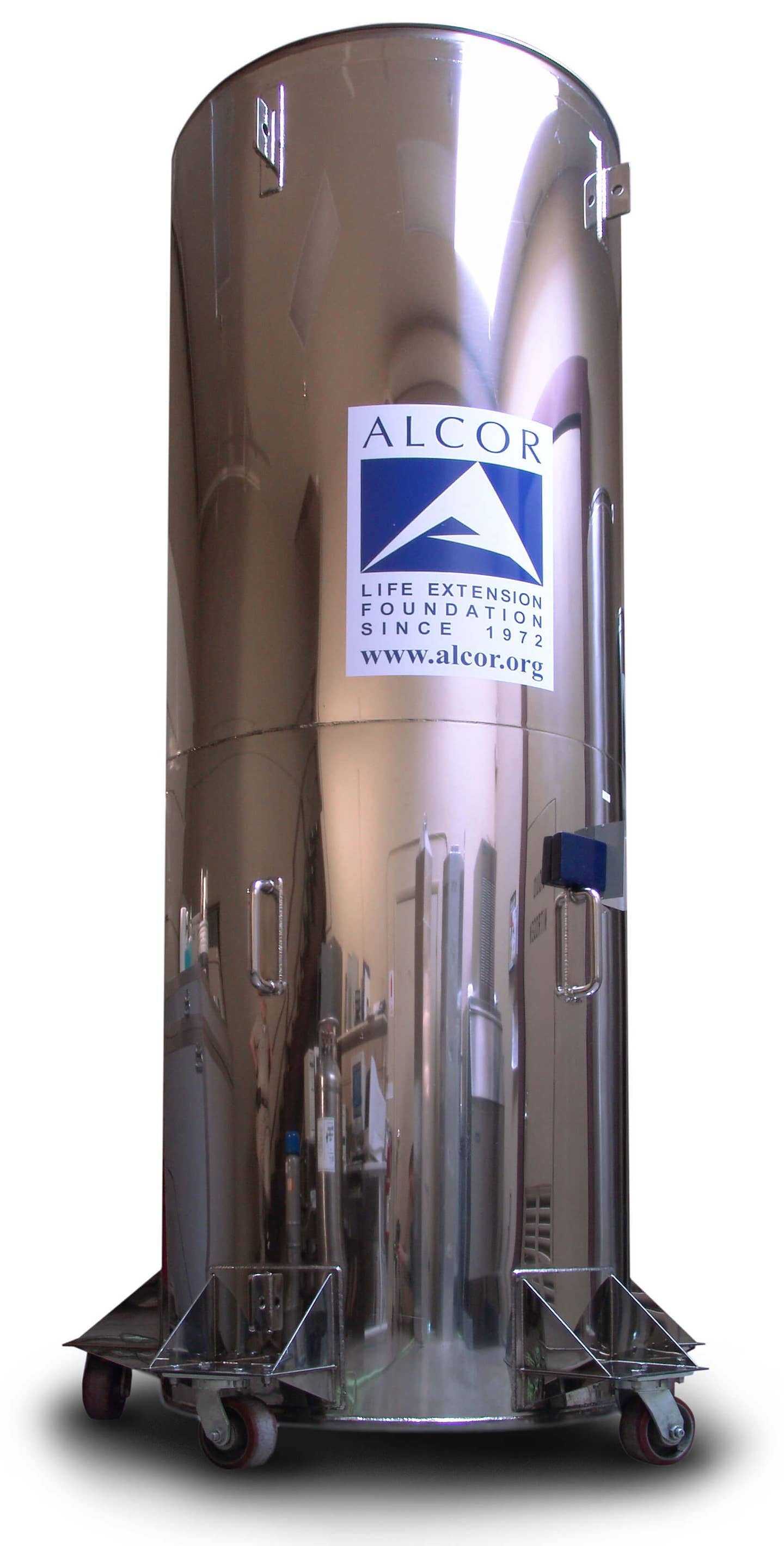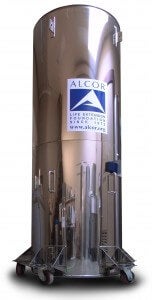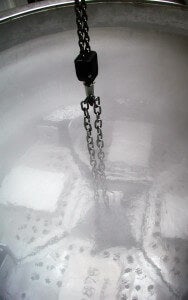Freezing Lazarus: The Cryonics of Eternal Life

Share

This bigfoot Dewar is custom designed to contain four wholebody patients and six neuropatients immersed in liquid nitrogen at -196 degrees Celsius. Photo courtesy Alcor
Want to live forever? You're not alone. For as long as we humans have contemplated our own mortality, the dream of eternal life has not been far behind. We see it reflected in our mythologies, religions, and cultural traditions, whether through a fountain of youth or an immortal soul in heaven. But the dream of cheating death has recently made the jump from superstition to science. Welcome to the world of cryopreservation.
Cryonics is the preservation of a body at low temperatures following legal “death,” with the expectation that future technologies will allow the resuscitation of the individual. The technique has reached the popular imagination through a mix of Hollywood portrayals (e.g. Austin Powers) and urban legends (sorry, but Walt Disney was actually cremated). Singularity enthusiasts hope that death will be but a long nap, and dream they might awaken to a futuristic afterlife here on Earth. But how much of this is science, how much is hype, and how much is faith? To find out, we’ve surveyed the landscape of cryonics today.
The logic of cryopreservation goes something like this. The medical definition of “death” has changed throughout history as new technologies became available. A century ago, people were considered dead if their heart had stopped beating. Today, lives are routinely saved through the use of a defibrillator shortly after a heart attack, even after a few minutes of cardiac arrest. Cancer was once a death sentence, and now people survive it regularly. How we define death is a function of the technology at our disposal.
Given the exponential rate of modern scientific innovation, cryonics suggests that new technologies may soon be available that can resurrect an individual considered “dead” by today’s standards. Because our personalities and memories have chemical foundations in the brain, they can hypothetically be preserved in the body, so long as neural tissue does not degenerate (as we'll see, that might be a logical jump). One way of preserving tissue is to store it at extremely low temperatures, effectively grinding your molecular chemistry to a halt. To put it bluntly, the cold keeps your body from rotting. But, as every high school student knows, your body is mostly water, which expands when frozen. This is where a process called vitrification enters the picture.
Cryonics patients are preserved in vats of liquid nitrogen cooled to temperatures below -200°F. Because ice crystals can damage cells as they form, the water that fills our cells must be partially replaced before the body is cooled. Chemicals solutions called cryoprotectants are circulated through the patient’s body, ultimately reaching a concentration greater than 50%. As the body is cooled, the cryoprotectants allow tissues to reach a glass-like solid state that is relatively free of ice crystals, thus preserving cellular integrity.
A central expectation of cryonics is that in the future, technologies will be available which allow us to resurrect cryopreserved bodies. The doctors who revive you will have to accomplish a number of tasks not yet within the scope of medical science (though suggested by advances in nanotechnology, stem cell research, and other topics we cover here at Singularity Hub). The vitrification process must be undone, restoring the cells of your body to their natural chemistry. The cause of your death must be reversed, repaired, or replaced, so that your body is more hospitable to life than when you died. You wouldn't want to be resurrected just to die all over again, right?
Some cryonics companies offer a less expensive “neuro option,” in which the head alone is cryopreserved; other companies avoid this altogether, wary of the stigma that frozen severed heads might bring to the public imagination. Still, as the lines between biological and artificial body parts continue to blur, it is conceivable that your brain alone – containing your personality and memories – could be revived and attached to another body (whether organic, artificial, or some combination thereof). If you've ever wanted to customize your body, here might be your chance.
Modern cryonics was born in 1962, when Robert Ettinger laid down its theoretical foundations in his book, The Prospect of Immortality. He went on to found the Cryonics Institute (CI), a nonprofit corporation in Michigan that remains a cryopreservation industry leader, as well as the Immortalist Society, an affiliate organization devoted to research and education about cryonics. The late sixties and early seventies saw a boom in both organizations and businesses devoted to cryonics. In 1967, the Cryonics Society of California (CSC) cryopreserved the first individual in human history, Dr. James Bedford. Alcor Life Extension Foundation, one of the companies at the forefront of cryonics today, was founded shortly thereafter in 1972.
In 1979, scandal struck the industry when it was revealed that nine individuals being preserved by CSC in Chatsworth, CA had thawed due to the financial hardships. The subsequent lawsuit and scandal – coined the “Chatsworth disaster” – brought bad publicity and slowed industry growth for a number of years. These early mistakes brought in an era of tighter financial control within cryonics companies, and nowadays each patient’s dues are carefully managed to ensure the security of their preservation.

A neuropatient, previously installed in a small cylindrical container, being lowered into liquid nitrogen vat. Photo courtesy Alcor
So how many people have undergone the deep freeze? Today, Alcor and the Cryonics Institute are the leading companies in the field. As of this month, Alcor has 85 patients, with another 888 living members signed up for cryopreservation upon their legal death. The Cryonics Institute houses 91 patients, 58 pets, and 785 living members.
One of the central ambiguities of cryonic technology – and an issue of careful rhetoric for its companies – is the question of how long after legal death a body needs to be vitrified. Immediate cooling is certainly ideal (Alcor suggests within fifteen minutes) as the cryoprotectants can preserve the body best within this window of time. While it would arguably be most beneficial to begin cooling the patient before legal death, current laws in the United States do not allow preservation procedures to begin until afterward. Shucks.
The upward time limit is difficult to determine, as the burden of reversing injury and resurrecting individuals still lies on undeveloped technology. If we can assume that 2 weeks is too long, the question still remains: When does dead mean dead? Even if our current standards are too conservative (legal death means zero brain activity, with the heart and lungs stopped), what are the limits of these hypothetical technologies upon which the cryonic dream is founded? Can they resurrect Lincoln? Or, more to the point, if I've been dead for 24 hours, am I still a viable cryonics customer?
Be Part of the Future
Sign up to receive top stories about groundbreaking technologies and visionary thinkers from SingularityHub.


Needless to say, the earlier, the better. Because of this, many cryonics companies consult with standby companies like Suspended Animation, Inc. For an additional fee, technicians will begin cooling your body immediately after your death. You will be maintained at a low temperature as you are transported to the facility where cryopreservation procedures will commence. Many companies offer packages that include standby support as part of the preservation fee.
So how much does cryopreservation cost? It depends on the options and the company. Most companies suggest that individuals pay through their life insurance policy, though direct payment is also accepted. The Cryonics Institute has introductory plans that range from $28,000 to $35,000 in addition to membership fees (about $120 annually). A full package which includes standby support runs around $100,000, though CI recommends that its patients keep a life insurance policy of $200,000 in case of future financial instability. Alcor requires a minimum insurance policy of $150,000 for whole body preservation, and a policy of $80,000 for neuropreservation alone. The cost of life insurance, of course, is determined by your health, lifestyle, and so on.
The biggest leap of faith surrounding cryonic preservation - and the greatest omission on the part of its proponents - is the sticky question of consciousness. It is generally accepted that your perceptions, cognitions and personality have biological foundations in the brain, but are these phenomena reducible to the three pounds of meat in your skull? It doesn't take the deus ex machina of a metaphysical soul to cast some doubt on this assumption. Debates over subjective experience and consciousness are at the forefront of neuroscience and philosophy today, simply because they are not well understood. The idea that your brain can be "rebooted," your existential being intact, is by no means a given. Until we better understand how consciousness emerges from matter, we cannot know whether it is even theoretically retrievable, futuristic technology or not.
And this is only the tip of the iceberg. Moral debates over cryonic preservation are wide-ranging indeed, from religious objections to questions of its environmental sustainability. Moral queries aside, the expectation of eternal life is no guarantee, as many cryonics companies recognize. Any number of unforeseen circumstances can interfere with your eternal life: war, political upheaval, environmental disasters, or (perhaps a more timely scenario) financial collapse. Can cryonics survive an economic depression? Can it survive peak oil? Any number of unknowns plague the practice, only some of which can be anticipated. To be fair, most cryonics companies are fairly straightforward about the dangers of an indefinite future.
The world of cryonics is an intersection of fascinating science and - paradoxically - a tremendous amount of faith. The expectations and projections at its core are not easily guaranteed, but neither are they easily refuted. "The future" looms over the entire enterprise and places the rhetoric of its proponents and critics alike in a space of fundamental uncertainty. But human hopes and dreams have always taken place on this sort of limbo, the gap between our knowledge and our imagination. Whether cryonics can reach its goals remains to be seen, and the debates will rage as the future unfolds. Some of us will sign up, cool down, and wait.
As for me? What can I say, I'm old-fashioned.
---
Here's a short feature on cryonics by ABC News:
Drew Halley is a graduate student researcher in Anthropology and is part of the Social Science Matrix at UC Berkeley. He is a PhD candidate in biological anthropology at UC Berkeley studying the evolution of primate brain development. His undergraduate research looked at the genetics of neurotransmission, human sexuality, and flotation tank sensory deprivation at Penn State University. He also enjoys brewing beer, photography, public science education, and dungeness crab. Drew was recommended for the Science Envoy program by UC Berkeley anthropologist/neuroscientist Terrence Deacon.
Related Articles

This Light-Powered AI Chip Is 100x Faster Than a Top Nvidia GPU

This Week’s Awesome Tech Stories From Around the Web (Through December 20)

Data Centers in Space: Will 2027 Really Be the Year AI Goes to Orbit?
What we’re reading